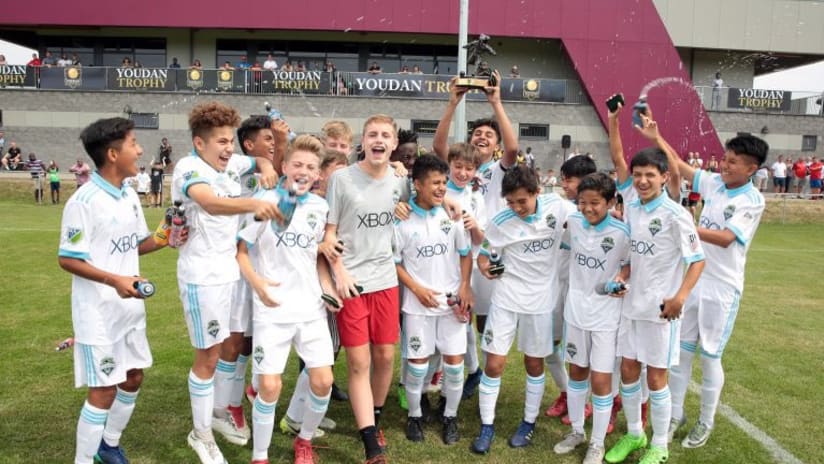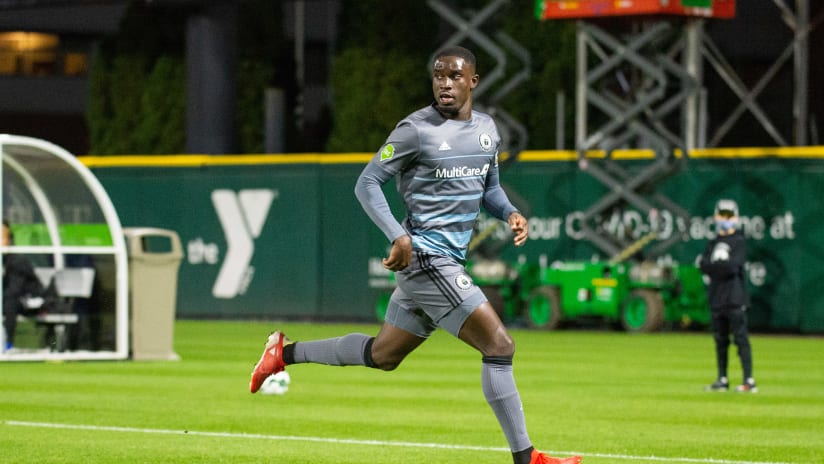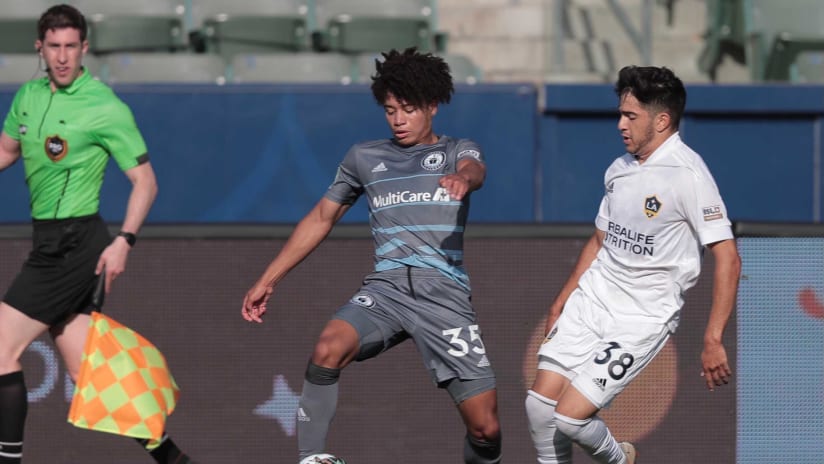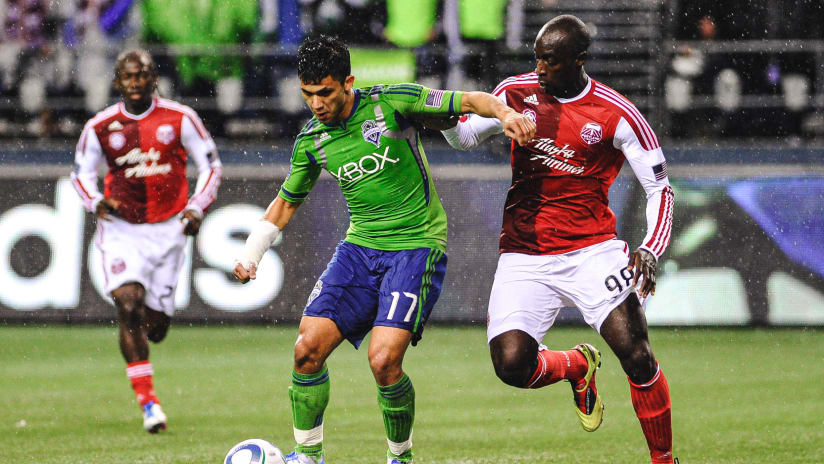Editor's Note: In just three short years, the Seattle Sounders’ investment in the Academy has led to three Youdan Trophy titles, over two dozen players receiving U.S. youth national team call-ups, a wave of teenagers signing pro contracts and a national championship.
This four-part series will trace the history of the last three years under General Manager & President of Soccer Garth Lagerwey, highlighting the initiatives, staffing hires and tectonic shifts in player development that turned Sounders Academy into a sustainable pipeline of elite prospects who will one day put on the iconic Rave Green jersey and play at CenturyLink Field.
Read Part I HERE.
Read Part II HERE.
Read Part III HERE.
International Exposure
In 2015, the Seattle Sounders Academy traveled outside the United States for the first time in club history and competed at the Neuville de Sur Tournoi in France. The Sounders’ U-15s finished ninth out of 16 teams, as England’s Newcastle United took home the title.
Fast forward one year, and that same Sounders Academy team defeated Newcastle en route to lifting the first of the club’s three Youdan Trophy titles in Sheffield, England, by defeating Swiss powerhouse FC Basel 1-0 in the final. Azriel Gonzalez, currently tearing it up with Sounders FC 2 in the USL, was awarded the Golden Boot as the tournament’s top scorer. Danny Robles, who signed with S2 two weeks ago on the back of his first call-up to the U.S. U-17 national team, was named Player of the Tournament.
The core of that team would repeat as Youdan Trophy champions in 2017, lift the 2017 Generation adidas Cup and take home the 2017-18 U.S. Soccer Development Academy national championship. Six players from that 2001/02 class are now on professional contracts, while the young Sounders who ventured to France on that inaugural foreign trip have combined for 2,170 USL minutes with S2 this season.
“We’re going into the unknown a little bit when we travel overseas, as you don’t know the level and you don’t know the opponent,” said Sounders FC Director of Player Development and Academy Director Marc Nicholls. “Of course, you’re playing against these clubs that have a lot of history and tradition. I think people see the famous kit that they see on TV and think that it makes these teams and these players better. But by traveling and experiencing it, our boys quickly realize that they’re as good, if not better, than some of these other clubs.”
Since that first international trip, Sounders Academy teams have won the Youdan Trophy three times, competed at the ICC Futures Tournament and Manchester City Cup and traveled to Japan for the Toyoma World Challenge. In 2017, the club sent a U-12 Sounders Discovery Program side to compete in the Truce Tournament, a two-week long tournament hosted by the English Premier League, which included clubs like PSG, Arsenal, Hertha Berlin, Manchester City and Anderlecht.
“It’s a major part of our DNA now, to challenge young players and promote them. If they’re good enough, it doesn’t matter how old they are."— U-15 Head Coach Dan Lock
In the past four years, Sounders Academy teams have defeated their age-group counterparts from Charlton Athletic, Liverpool FC, Everton FC, Manchester United, Manchester City, Tottenham Hotspur, FC Basel, Club Tijuana, Newcastle United and many, many others. While those results are impressive in the short-term, it’s the long-term cognitive effects — realizing that they can compete against the world’s best on foreign soil — that will pay dividends as these players begin to break into the First Team.
“While we respect these international clubs, we’ve found that we have nothing to fear,” said Nicholls. “When the boys realize that, it gives them a lot of confidence, a lot of belief, in their own club. There’s an expectation now when our players travel that they’re going to do well. It’s important for our players to understand that they’re good. And why shouldn’t they? It’s given them all that belief, excitement, and challenge to continue to develop.”
Another important vehicle for international exposure is U.S. youth national team involvement.
In 2014, only a handful of Sounders Academy players had ever been called up to youth national teams at any age group. But in the past year, over 15 players have represented the Stars and Stripes at the U-14, U-15, U-16, U-17, U-18, U-19 and U-20 levels.
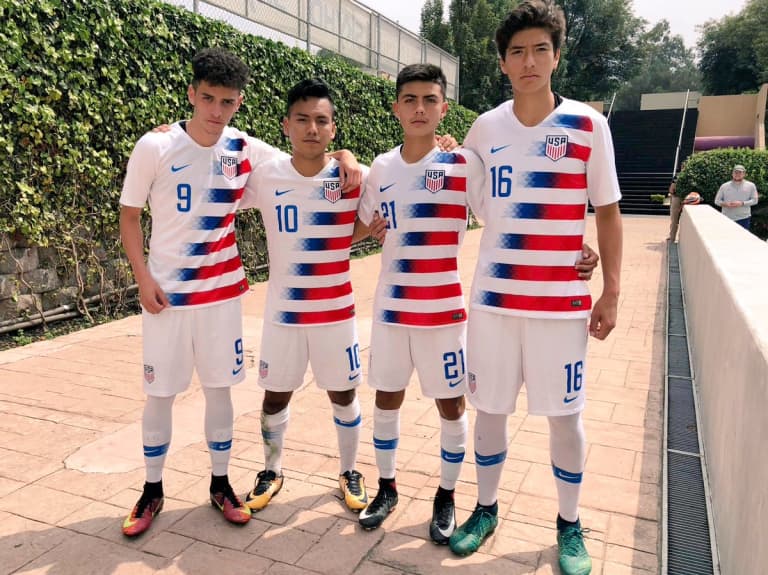
Sounders Academy prospects Alfonso Ocampo-Chavez, Danny Robles, Ray Serrano and Josh Atencio with the U.S. U-17 national team in Mexico | Sheila Tatsunami
Focusing on the construct of exposure, youth national team involvement is an important element of player development. To make the roster for a USYNT camp, you have to be at the zenith of players in your age group. Once in camp, you’re competing against the top talents from around the country to get called back for the next event. After becoming a regular invitee, you must then progress to the point where you’re locked in to start.
But it doesn’t stop there. Once you make the Starting XI, you then go toe-to-toe with the best players in the world as you represent your country.
“Ultimately, we want our players to have to fight, and sometimes struggle, and receive setbacks,” said Nicholls. “Being called into the national team provides them with an opportunity, something to strive for. But at the same time, players understand that it’s not a given. In order to continue to be called back, they need to make an impression immediately. They need to walk into a locker room or an environment that they’re unfamiliar with, and that’s part and parcel with being a professional soccer player.”
Taking players out of their comfort zone and challenging them at the club level is already paying dividends on the international scene, with S2 forward Alfonso Ocampo-Chavez scoring goals for the U.S. U-17s against Brazil and Argentina in the past month.
Academy Exposure
In domestic competition, the Academy remains fully dedicated to the principle of exposure for its top prospects.
Since 2015, the club has used Generation adidas Cup, a year-long tournament that pits MLS academies against international sides like Real Madrid and Flamengo, as a medium for evaluating elite players in a hyper-competitive environment. The coaches utilize the first round of qualifying, which starts in October, to promote players from the U-15s to the U-17 squad, with the ones who impress the most continuing to play up in USSDA matches afterward.
This process truly makes the entire youth system a meritocracy. It prepares prospects for the rigors of professional soccer, immersing them in a culture where they must compete for their spot in the Starting XI every night at training.
“It’s a major part of our DNA now, to challenge young players and promote them,” said U-15 Head Coach Dan Lock. “If they’re good enough, it doesn’t matter how old they are. I think it just builds a good philosophy through all the age groups because all the kids know that if they perform to a high level consistently, they’ll get rewarded. So, it not only creates competition within their age group, but it creates competition throughout the entire Academy because the U-17s know that if they’re not working hard, there are younger players who can come up and take their spot. It’s a healthy competition and it’s really good to see all the older players embrace the younger players.”
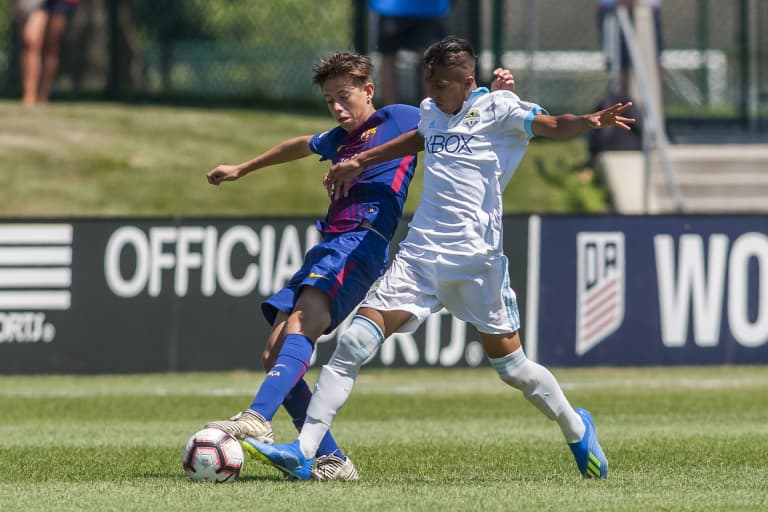
S2 midfielder Danny Leyva, 15, played two years up in every single playoff match as the U-17s won the USSDA national championship | Nick Smith
Talent is too rare to stand still, so regularly fielding players up an age group is critical to accelerating development. It forces them to be more efficient with their off-the-ball movement, find better spaces and make quicker decisions. However, it’s equally important for players to enjoy success in their own age group, as it builds confidence.
“In 2011, we weren’t able to take a player and push him up 2-3 years and really push him out of his comfort zone, and then bring him back to play him in a different game in his age group,” said Head Scout Sean Henderson. “It has become this full-on developmental program where the individual player has their own pathway, and that just wasn’t possible in the early years.”
In 2015, it was Gonzalez who played up at GA Cup. After his development was accelerated by being pushed out of his comfort zone, the club brought Josh Atencio, Ray Serrano, Robles and Ocampo-Chavez to the first round of qualifying in 2016. That quartet recently traveled to Mexico with the U.S. U-17 national team, and three have signed with S2.
The core of the U-17 team that won the USSDA national championship in July spent the previous season playing up an age group. With that year of experience under their belt, the U-17s compiled a record of 27-3-3 record with a goal difference of plus-81 in 2017-18. In their playoff run, they regularly fielded a team made up of four 2002s and two 2003s as Seattle claimed the national title with the youngest side in the competition.
Professional Exposure
Perhaps the biggest benefit of consistently challenging players and taking them out of their comfort zones in the youth ranks is that it eases the transition into professional soccer. Playing against grown men in the USL would be daunting for any teenager. But for players in the Sounders Academy, making their professional debuts at 16 years old isn’t a petrifying experience, as they’ve already been playing above their age group, against some of the best players in the world, for several years.
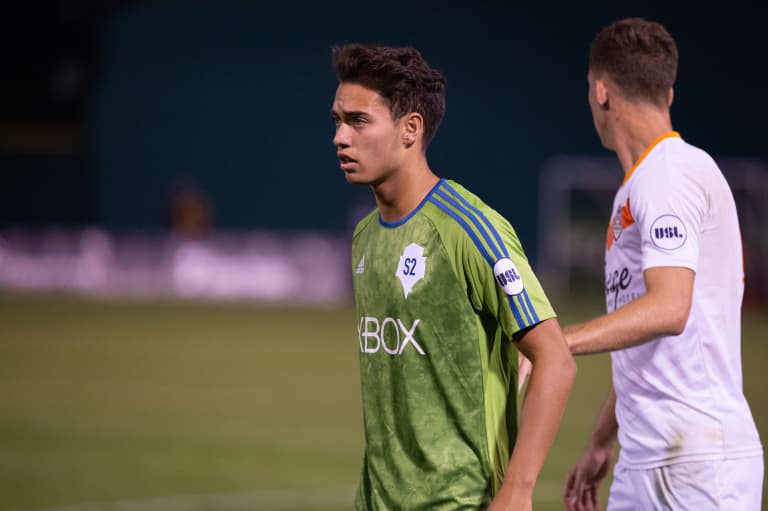
Alec Diaz, 16, who scored the game-winning goals in the GA Cup final and USSDA national championship match, makes his S2 debut against Tulsa | Charis Wilson
In the 2018 USL season alone, 21 players who are still age eligible to compete in the Academy received playing time with S2, combining for over 9,000 minutes. While that’s a significant achievement, especially in the American soccer landscape where clubs are reticent to hand the reins to teenagers, the club isn’t resting on its laurels.
“That’s the goal, that’s what we’re looking for,” said Academy Director of Coaching and U-17 Head Coach Chris Little. “I’m very pleased for the boys. But at the same time, it’s also about holding them accountable at the highest level. What we always say to them is, ‘If you look at Europe, there are guys your age playing regular First Team football. So, that should be your goal. How can you get to that?’
“For us, the bridge there is S2, so it’s a natural progression. Am I happy that they’re playing for S2? Sure. But I’m going to be happier when they’re contributing and successful at the [First Team] level.”
While this increased quality of competition certainly accelerates development, it’s the constant exposure to professional soccer, and the talented international-level players on the First Team, that will pay off in the long run.
“When Ray Serrano goes to preseason with the First Team, and he trains them on a somewhat regular basis with them, and a player like Clint Dempsey, or Víctor Rodríguez or Nicolás Lodeiro takes him under their wings and helps with his development, that is how players get better,” said Henderson.
Perhaps most importantly, this exposure will accelerate the trajectory of each player’s professional career. In the past, a Homegrown signing like DeAndre Yedlin wouldn’t play his first professional minutes until he was 21 because he would have spent several seasons playing college soccer.
"I think that in two years' time, 80 percent of S2 will players will be from our Academy. I'll be very disappointed if, in three years' time, our First Team roster isn't made up of 6-8 Academy graduates, so 25-30 percent of the roster." — Director of Player Development and Academy Director Marc Nicholls
As a senior at Ballard High School, center back Sam Rogers, who spent five years in the Academy, amassed 2,250 professional minutes for S2. Gonzalez, 17, has already played 1,427 professional minutes, with three goals, four assists and 16 key passes in the USL to his name. Sixteen-year-old forward Alec Diaz has already registered two goals and two assists with S2, while Marlon Vargas, 17, has racked up seven starts in the USL.
With so many young talents breaking into S2 throughout the last two years, the club is certainly on track to reach its stated goal of having top prospects play 100 professional matches by the time they’re 21 and challenging for a starting job with the First Team.
“I think that in two years’ time, 80 percent of S2 players will be from our Academy,” said Nicholls. “I’ll be very disappointed if, in three years’ time, our First Team roster isn’t made up of 6-8 Academy graduates, so 25-30 percent of the roster. That has to be our overall goal. We want to win cups and championships. We think that’s good for development and good for the club. But it’s not worth anything unless these players are signing, playing and contributing to our First Team.”

